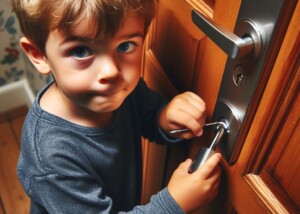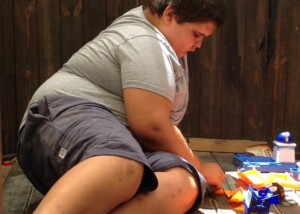Once again an autistic preschooler escaped overnight and was found dead a few days later. Parent fail!
This was a preschool child, not a buffalo.
Before I explain the many ways parents can prevent an autistic child from eloping or escaping overnight or in the wee hours of the morning, I’m going to cite my relevant experience.
Though I don’t have the experience of raising an elopement-prone, severely autistic child, I DO have the experience of making sure that an adult family member did not “escape” overnight.
She was my mother. Following cardiac surgery, she had impaired judgement.
Alongside that, for reasons none of her medical team could explain, she’d begin blacking out – with increasingly impaired cognition – quickly after getting up from having been sitting for a while or lying in bed.
She lacked the judgement to realize what was happening and immediately take a seat.
Instead, she’d remain on her feet, headed towards passing out – only she never fully passed out because I’d be at her side to gently guide her to the nearest chair, or, depending on variables, into a seated position on the floor.
So how did I manage this conundrum overnight while my mother slept?
The technique I used, to ensure that 100 percent of the time I’d always know when she exited her bedroom, is ONLY ONE of many approaches that parents of autistic children can use – to be alerted whenever their child commences elopement overnight.
Thus, I recommend it as part of a bigger picture of a comprehensive elopement prevention regimen.
While my mother was recovering from the surgery, I lived with my parents.
I slept on the first floor while they slept upstairs with the bedroom double doors closed.
The danger was if she left the bedroom, rather than remained inside to just use its bathroom.
So I hung several big jingle bells on the door latch.
If she opened the door from inside the bedroom, the external latch would move, causing the lanyard of bells to fall to the floor.
It was impossible for me to sleep through this noise. I’d race upstairs and be right at her side to prevent her from fainting.
So my first recommendation is to hang a lanyard of big noisy jingle bells on your autistic child’s door.
However … if this can’t be rigged due to the nature of the doorknob, there are many other options! Keep reading!
Blame the Parents, not the Autism

©Lorra Garrick
I’m clinically diagnosed with autism. I was never an eloper.
Elopement risk is associated with severity of ASD. Plus, if the child also has an intellectual disability, this compounds the issue.
I’m always so livid at parents when their autistic child gets away overnight.
These parents did NOT do their best. How does a young child, especially preschool age, manage to “escape” in the first place?
This is easy if the door has no reinforcements. But if parents know their autistic young one is at risk for eloping, then it’s on the parents to have the door reinforced.
A deadbolt that locks from the inside would outright prevent that young child from getting out.
Disagree? Then you tell me just how a three-year-old could locate a hidden key and then unlock a deadbolt that’s way too high for them to reach.
Are they capable of shoving a chair under the lock to reach it? Well, if the key is hidden, this wouldn’t matter!
The key could even be worn around the parent’s neck overnight, or in a pocket of their jammies.
I’ve never heard of a case in which the escape occurred through a window, but cheap alarms can be installed that will loudly go off if a window begins to slide open.
The latest case I read of, in May 2024, involved a three-year-old who had fallen into a canal. This was an entirely preventable tragedy.
I’ll bet the farm that the door he exited had no additional reinforcements: just a common simple lock system that any three-year-old could figure out after watching their parents use it.
Locks and Alarms
Install high quality locks on all doors and windows.
Use locks that are out of reach or difficult for the child to manipulate.
Additionally, install alarms that alert you if a door or window is opened.
Window alarms range from very simple to sophisticated.
All of these products can be found on Amazon.
These children are not locksmiths. They are getting out because the lock system is a rudimentary latch that you simply turn.
In more sophisticated escapes, the autistic child has placed something beneath the lock to climb up on and reached a latch or security chain.
An inside deadbolt, key hidden or locked up in a padlocked box, would prevent an escape – unless the child was older and knew how to pick a deadbolt.
But keep in mind that many elopers are too young to master lock picking! They got out because there was no security in place!
The solution to lock picking is an alarm that sounds the moment the door moves.
Now I don’t want to hear that this still won’t work if the child can outrun the parents.
I’ve yet to read of a case in which the youngster would sprint away like a track star the second they were out the door.
The parents know they have an autistic child who likes to wander away.
This means it’s their responsibility to modify their lifestyle to accommodate risky behaviors.
Every night when the parents go to bed they need to be ready to jump out of bed and dash like a demon to the door upon hearing the alarm.
- Have sneakers by the bed.
- Run for fitness in case you need to run after your child!
- Don’t smoke, and keep your weight healthy to optimize your running abilities.
- Make sure the path from your bedroom to any doors is clear before you go to bed.
Additional Technology
Install motion sensors that can alert you to movement within the home during the night.
These sensors can be placed in hallways, near exits or in the child’s room.
Alert systems: Some devices offer geo-fencing capabilities, sending an alert to your phone if the child leaves a predetermined area.
Wearable devices: Invest in a GPS tracking device that your child can wear, such as a bracelet or shoe insert. These devices allow you to monitor your child’s location in real-time.
It’s not Rocket Science to Keep a Young Child Inside a House Overnight
There are many other strategies that can be part of an elopement plan, such as placing a stop sign on doors before going to bed, to remind your child not to leave.
Another tactic is to have your child use a heavy blanket, which may make them feel more secure and thus, less likely to want to leave in the middle of the night.
But this article is primarily about physical barriers and alert systems, which are very much lacking in real cases of elopement.
I’ve yet to hear a parent say, “My five-year-old somehow disabled the alarm, then got the key off my neck while I was asleep and got out.”
It’s a good idea to make sure your child doesn’t know you wear the key to sleep.
If you don’t like wearing something around your neck while asleep, then you can always find a hiding spot for the key that your autistic child, no matter how bright, would never think to look. Or keep it in a padlocked box in your bedroom.
There’s one last consideration here: money. Not everyone can afford an elaborate alarm system.
But the alarms need not be complex or elaborate. Noise making alarms for windows are cheap.
So are jingle bells fastened to lanyards. An indoor deadbolt and its installation is also cheap.
A motion sensor system and the addition of more locks on the windows, plus other physical deterrents, do come with more cost.
But you then must ask yourself: “What can I give up, that I don’t need, to save up some extra money?”
The safety of an autistic child is worth it!
 Lorra Garrick has been covering medical and fitness topics for many years, having written thousands of articles for print magazines and websites, including as a ghostwriter. She’s also a former ACE-certified personal trainer. In 2022 she received a diagnosis of Level 1 Autism Spectrum Disorder.
Lorra Garrick has been covering medical and fitness topics for many years, having written thousands of articles for print magazines and websites, including as a ghostwriter. She’s also a former ACE-certified personal trainer. In 2022 she received a diagnosis of Level 1 Autism Spectrum Disorder.
.










































